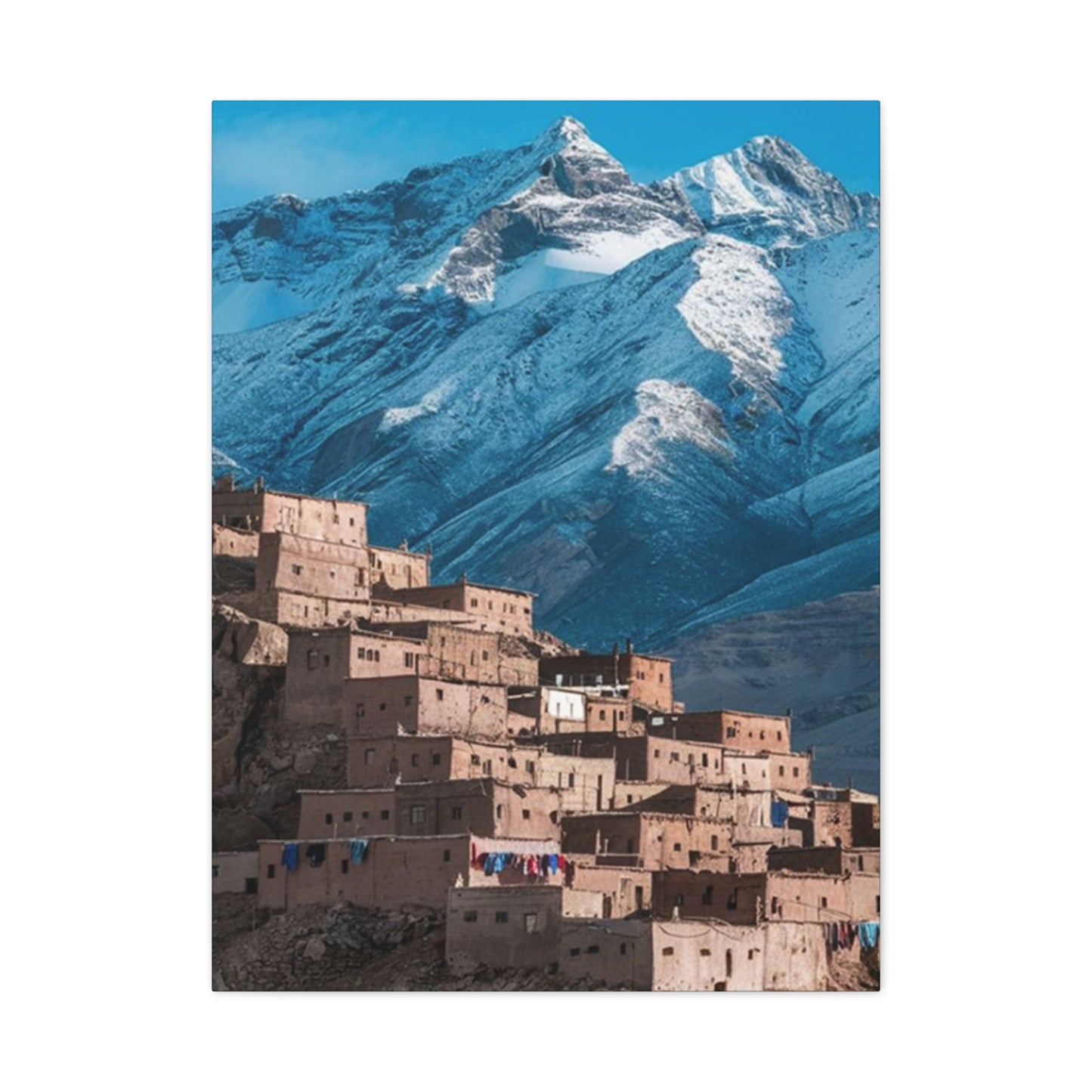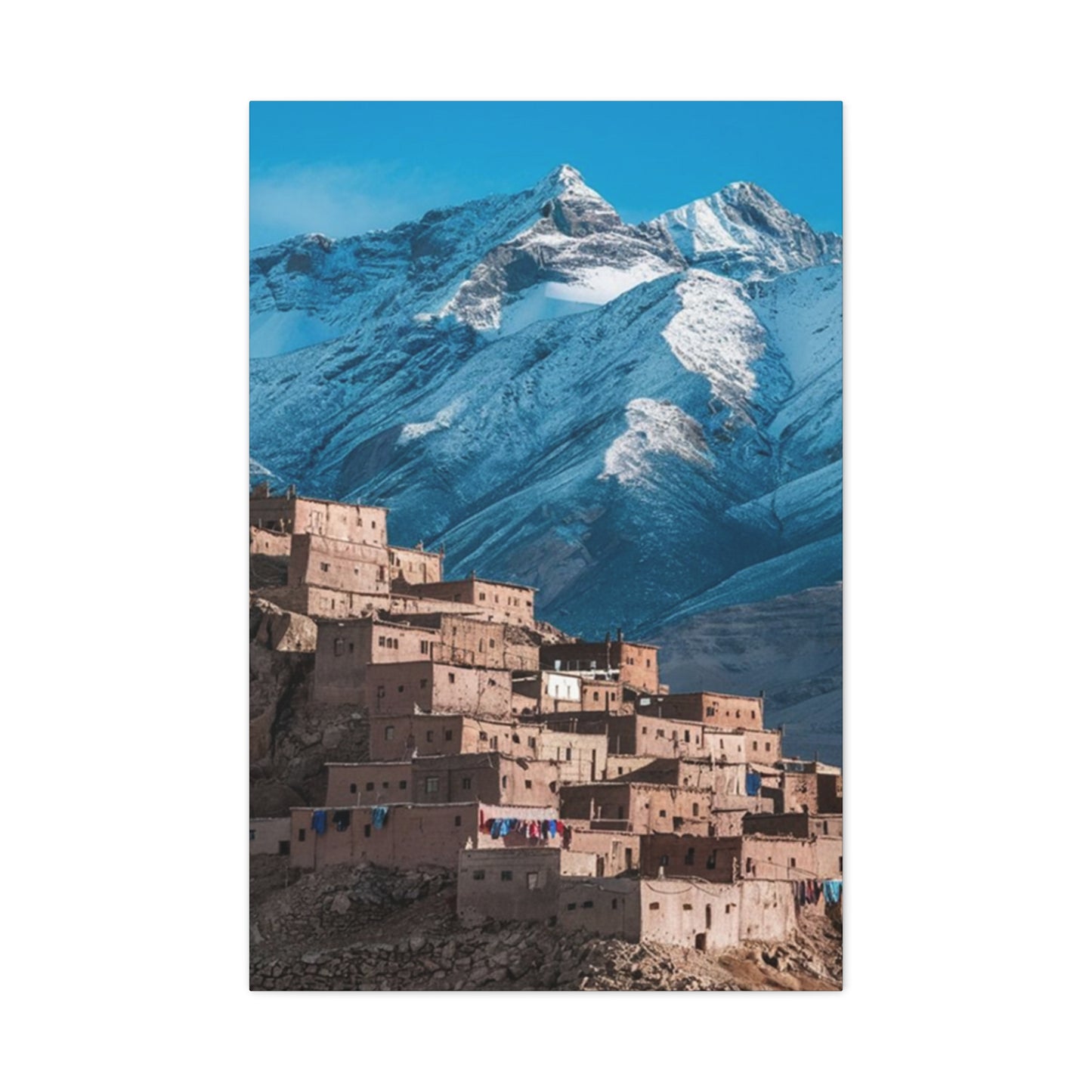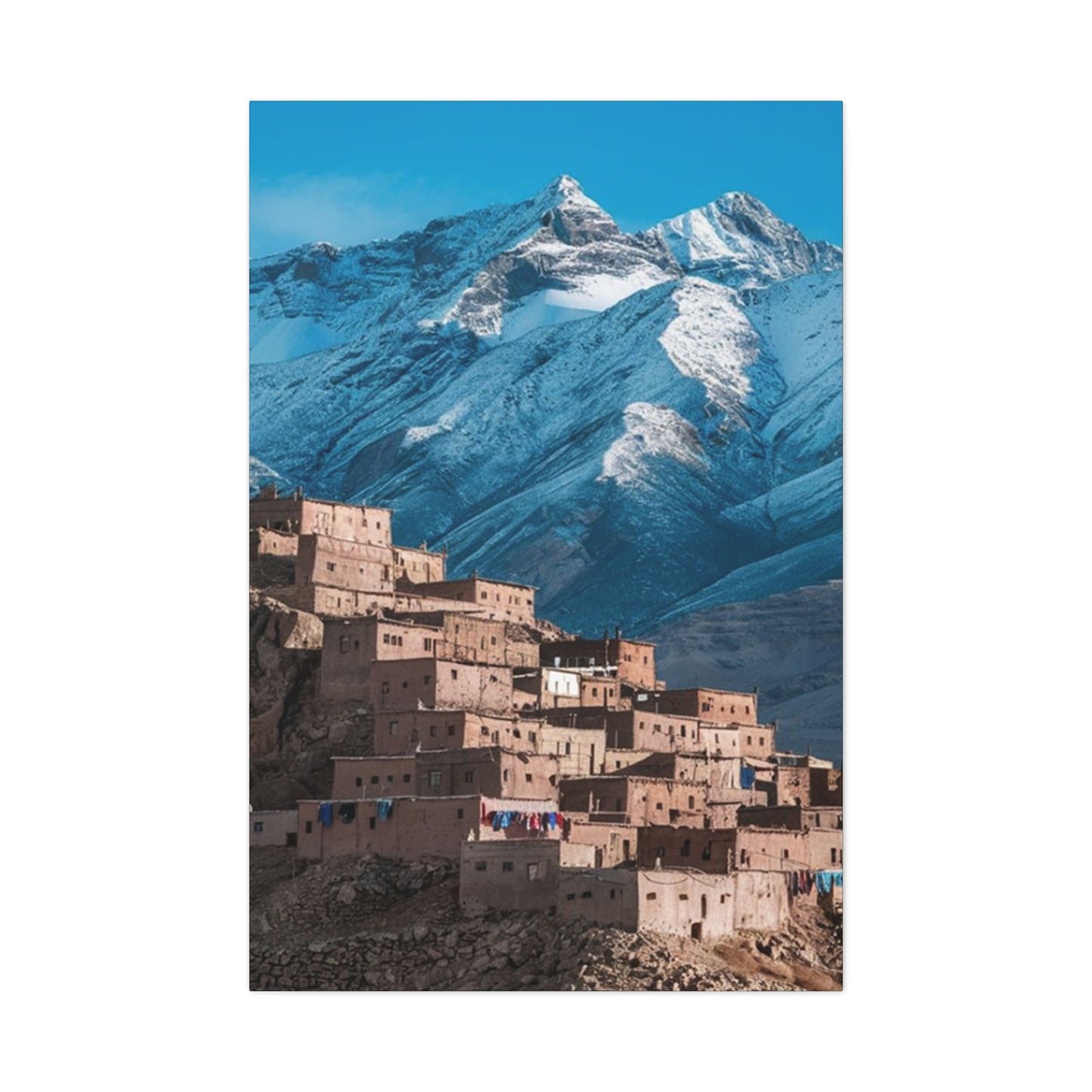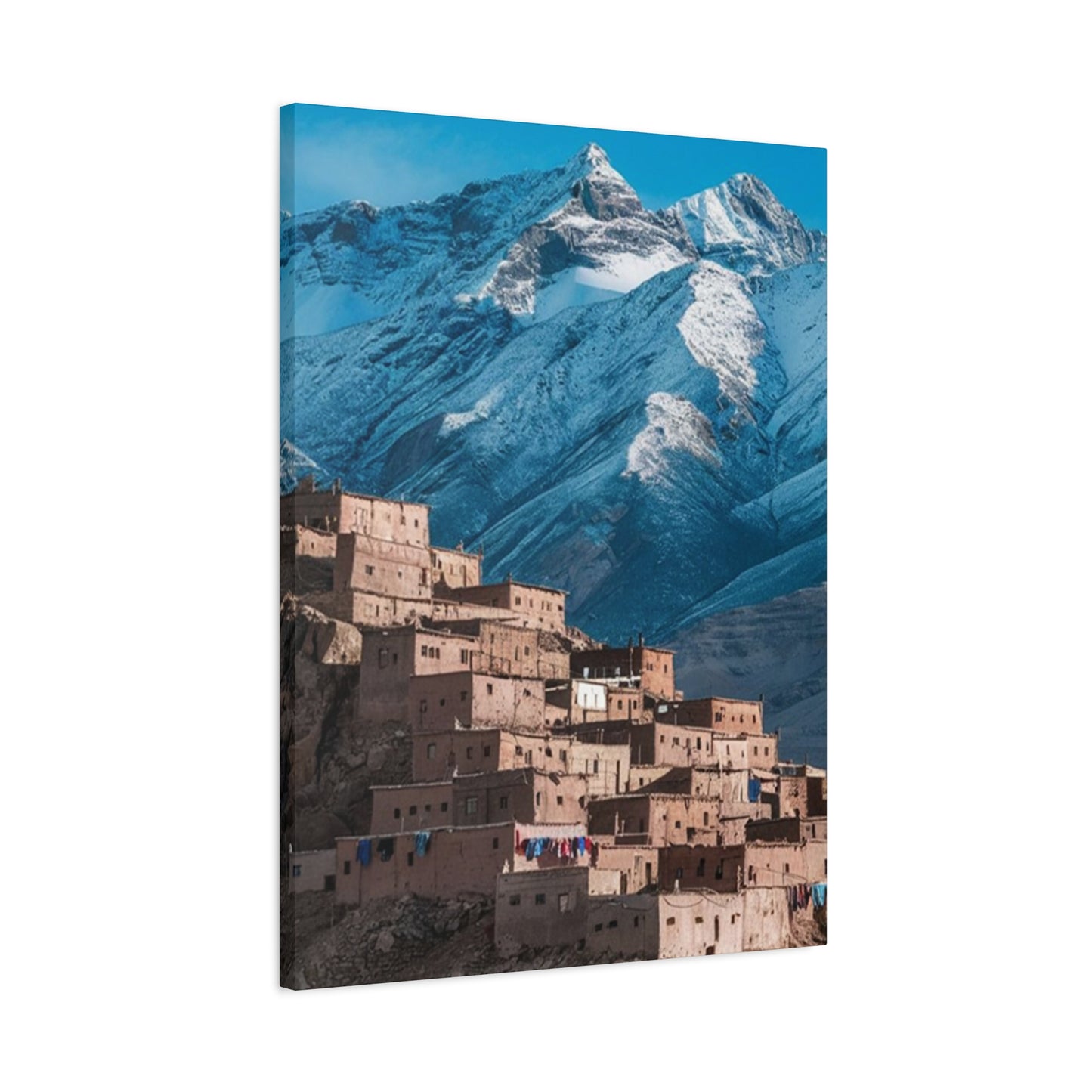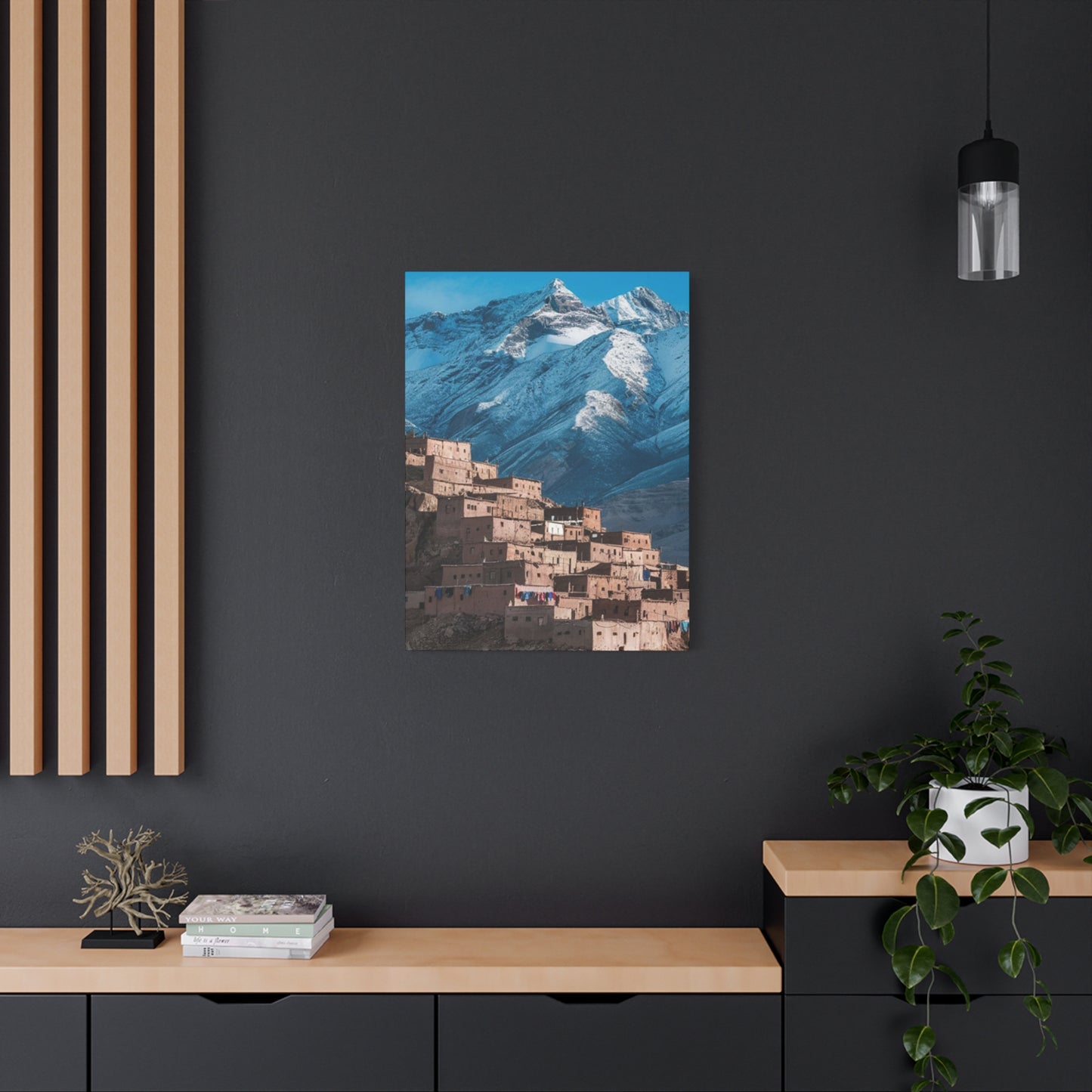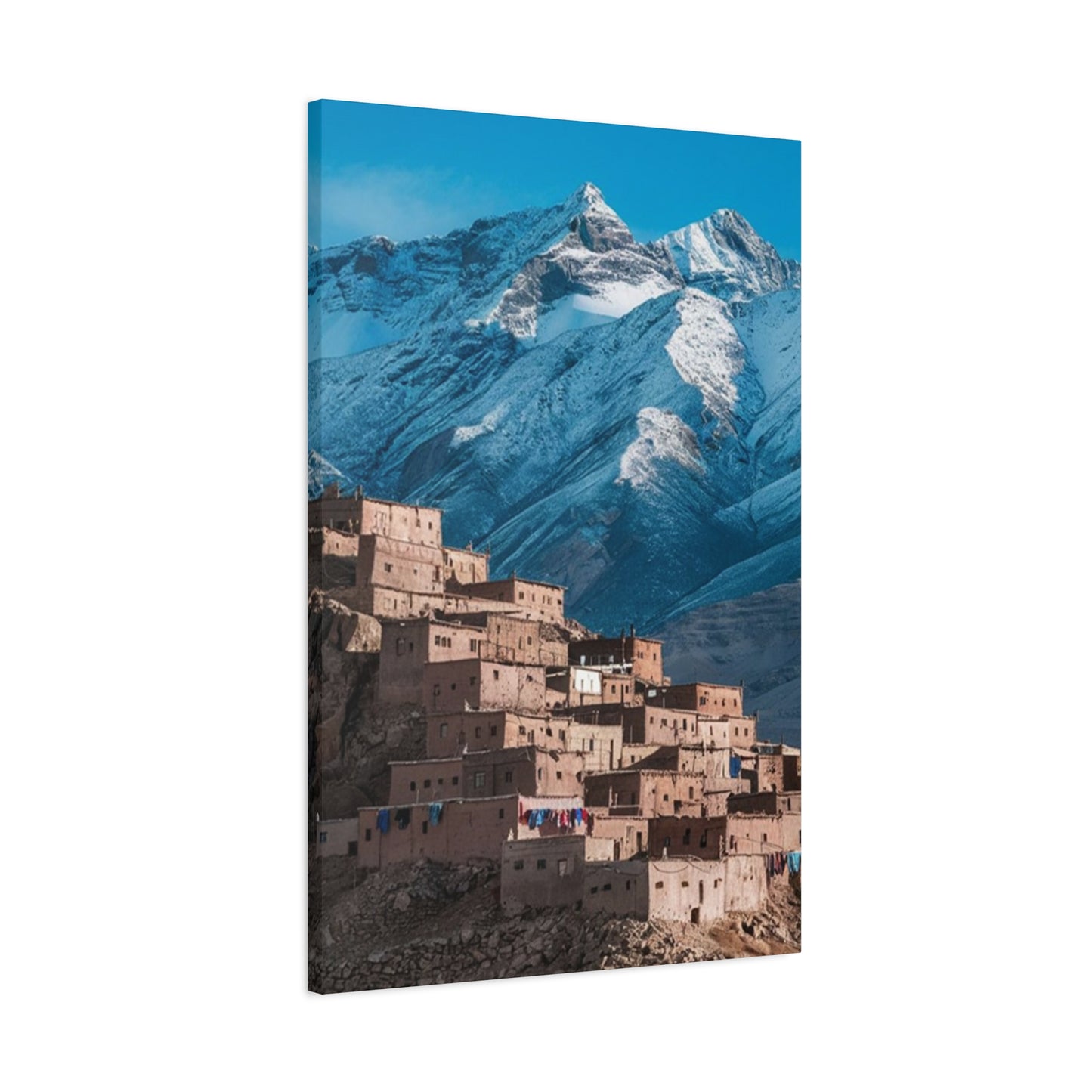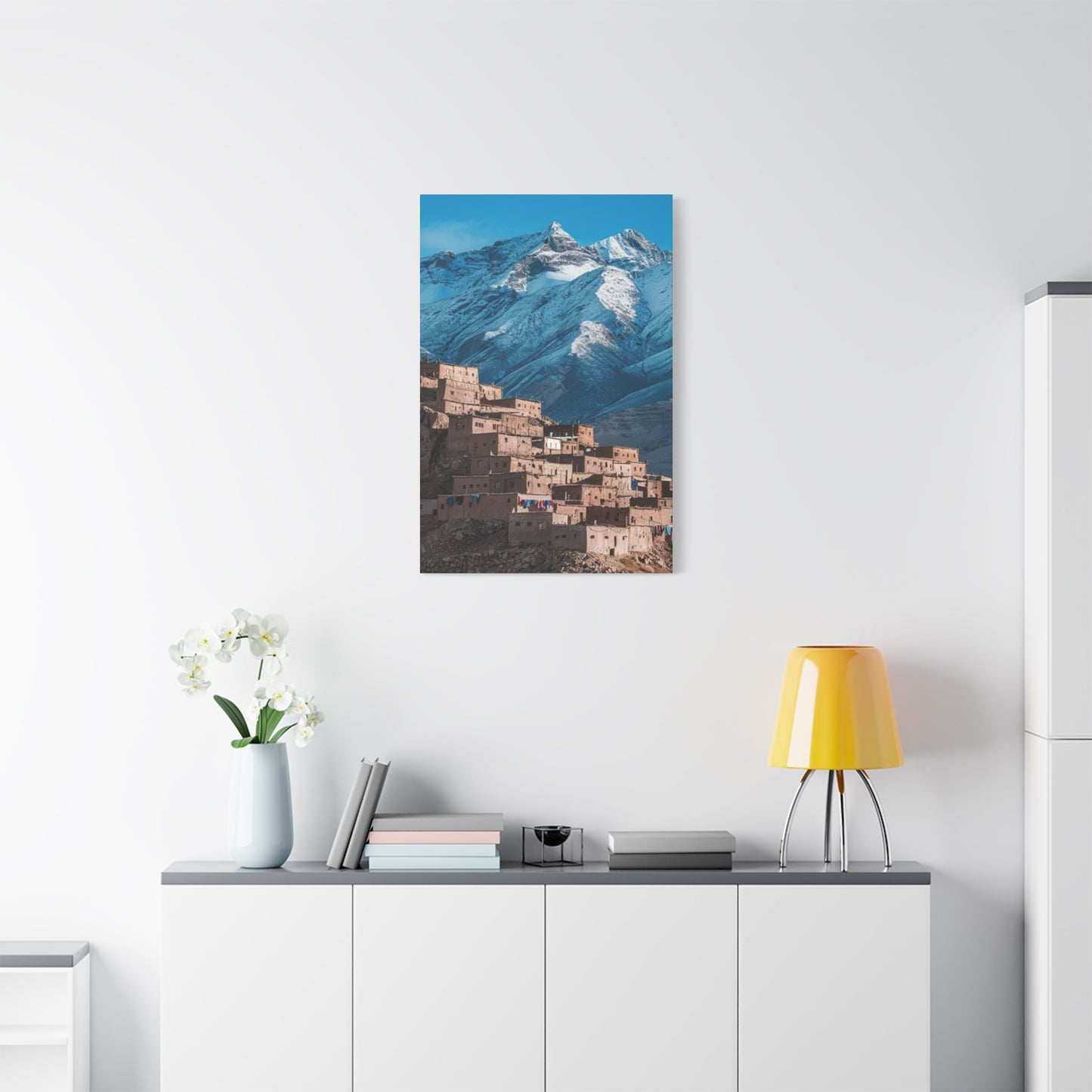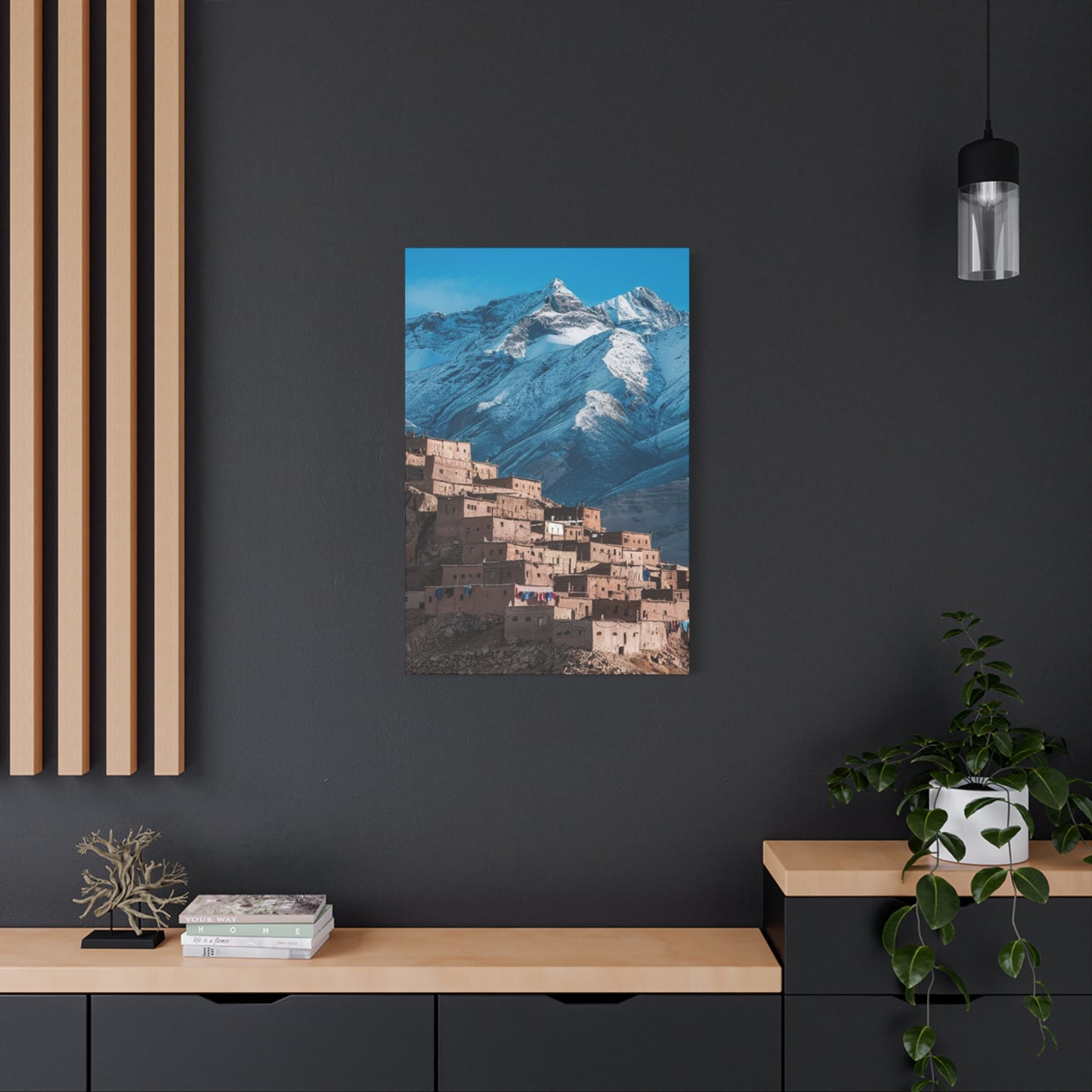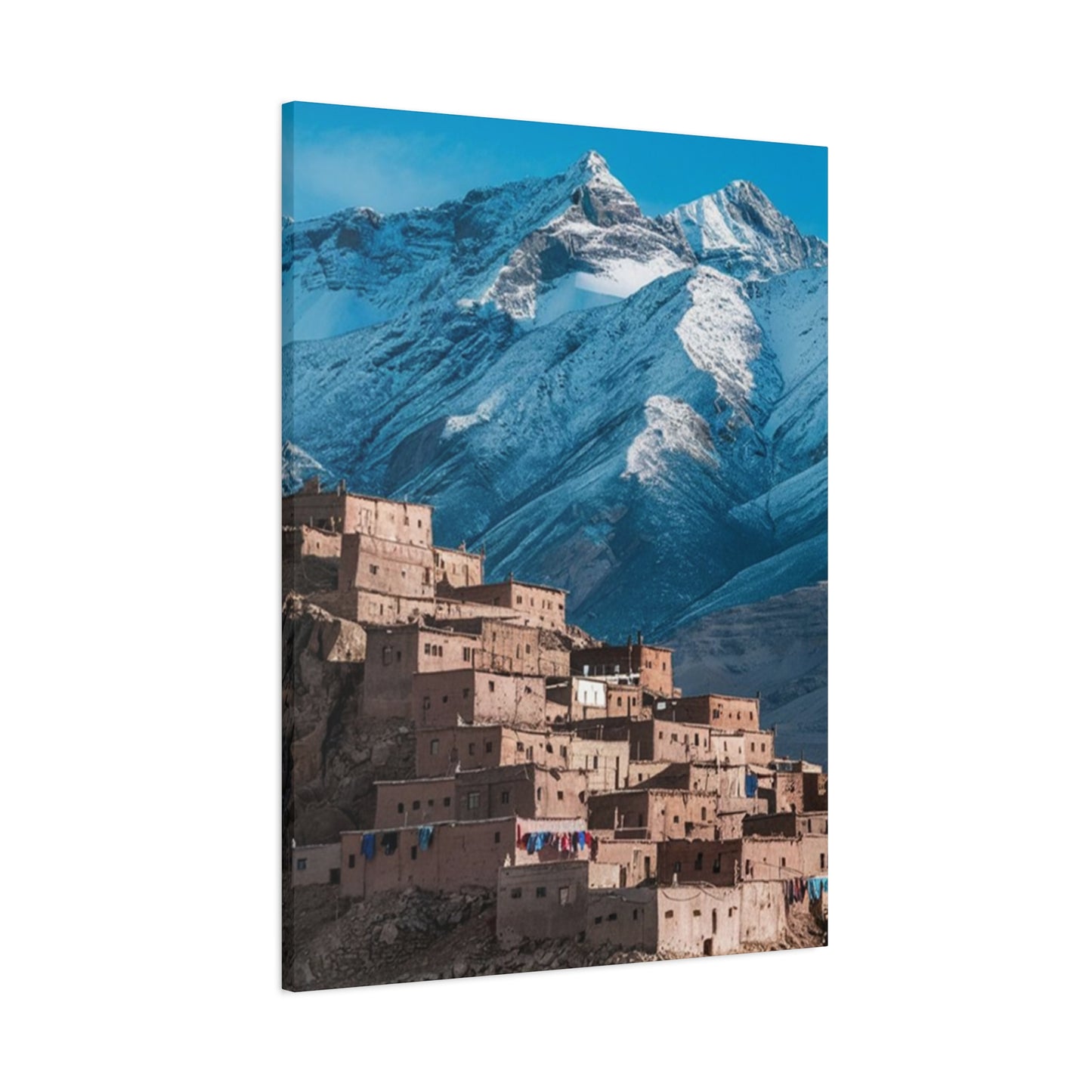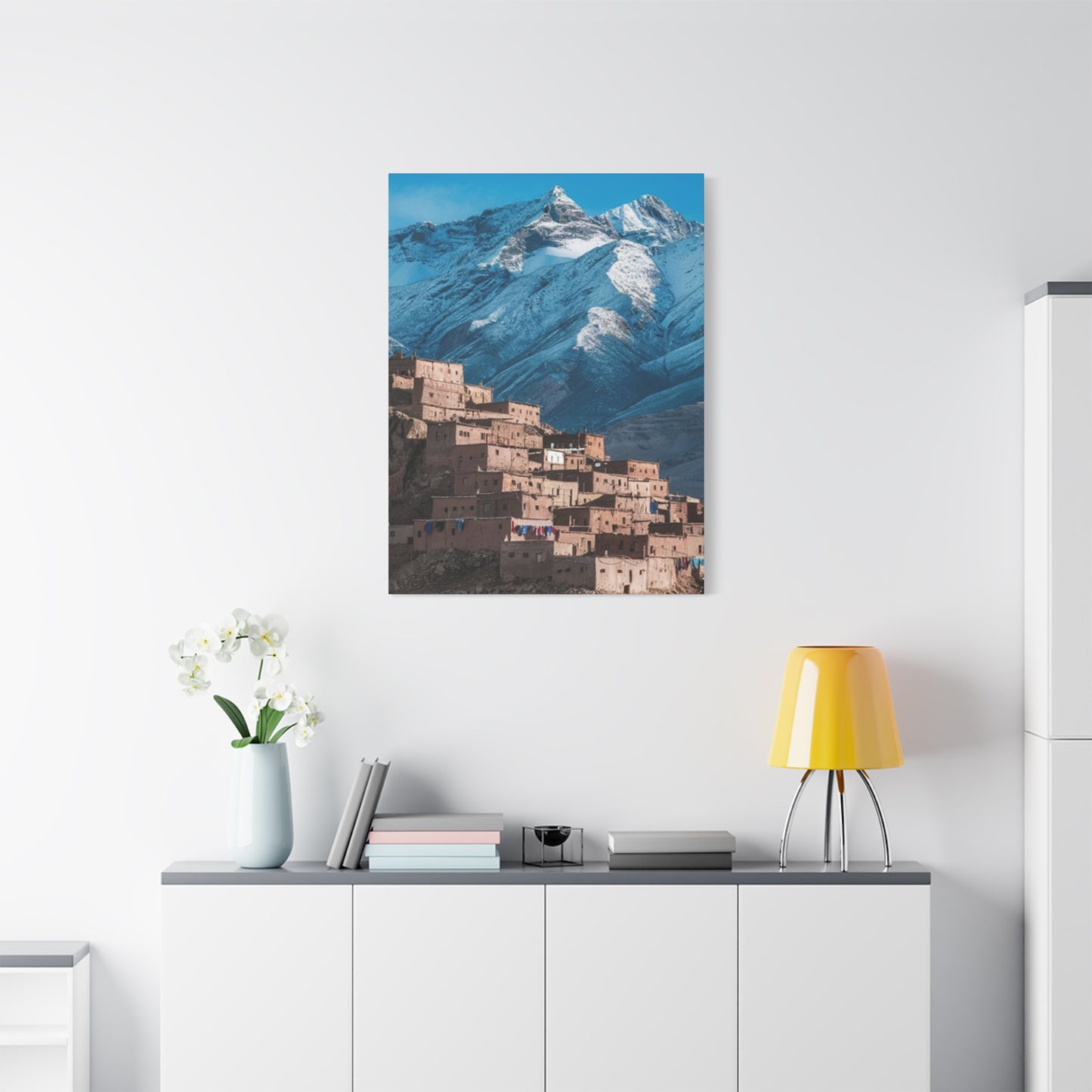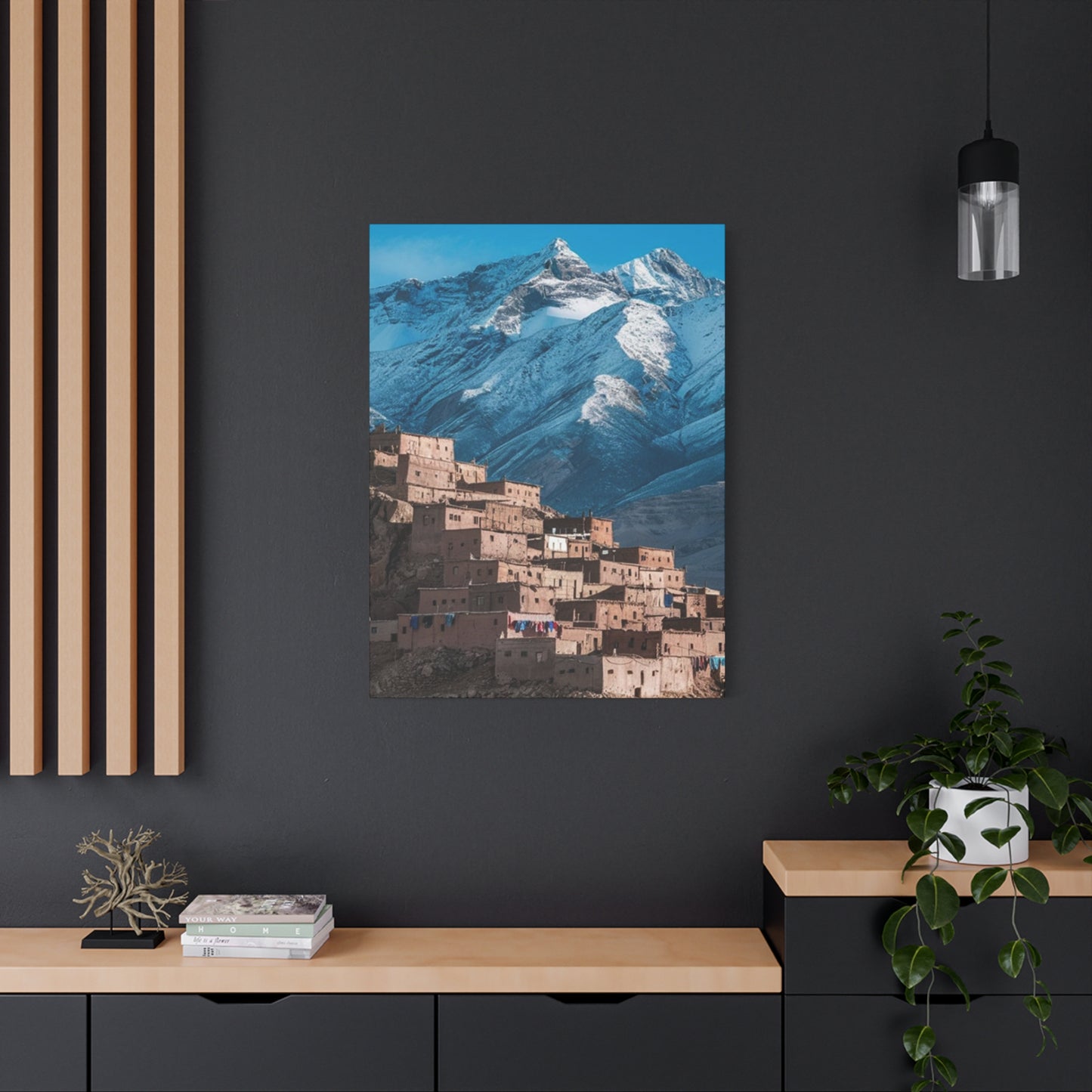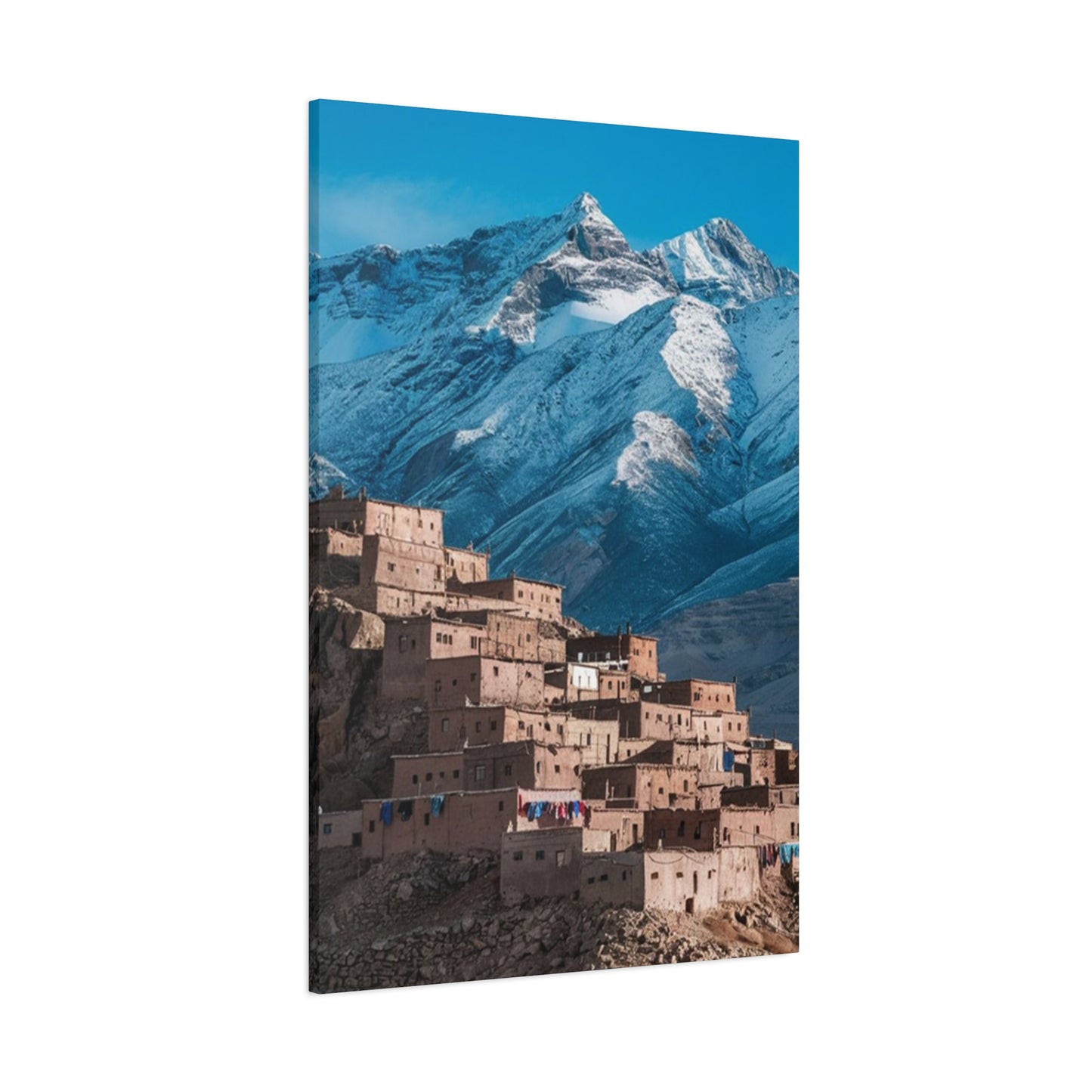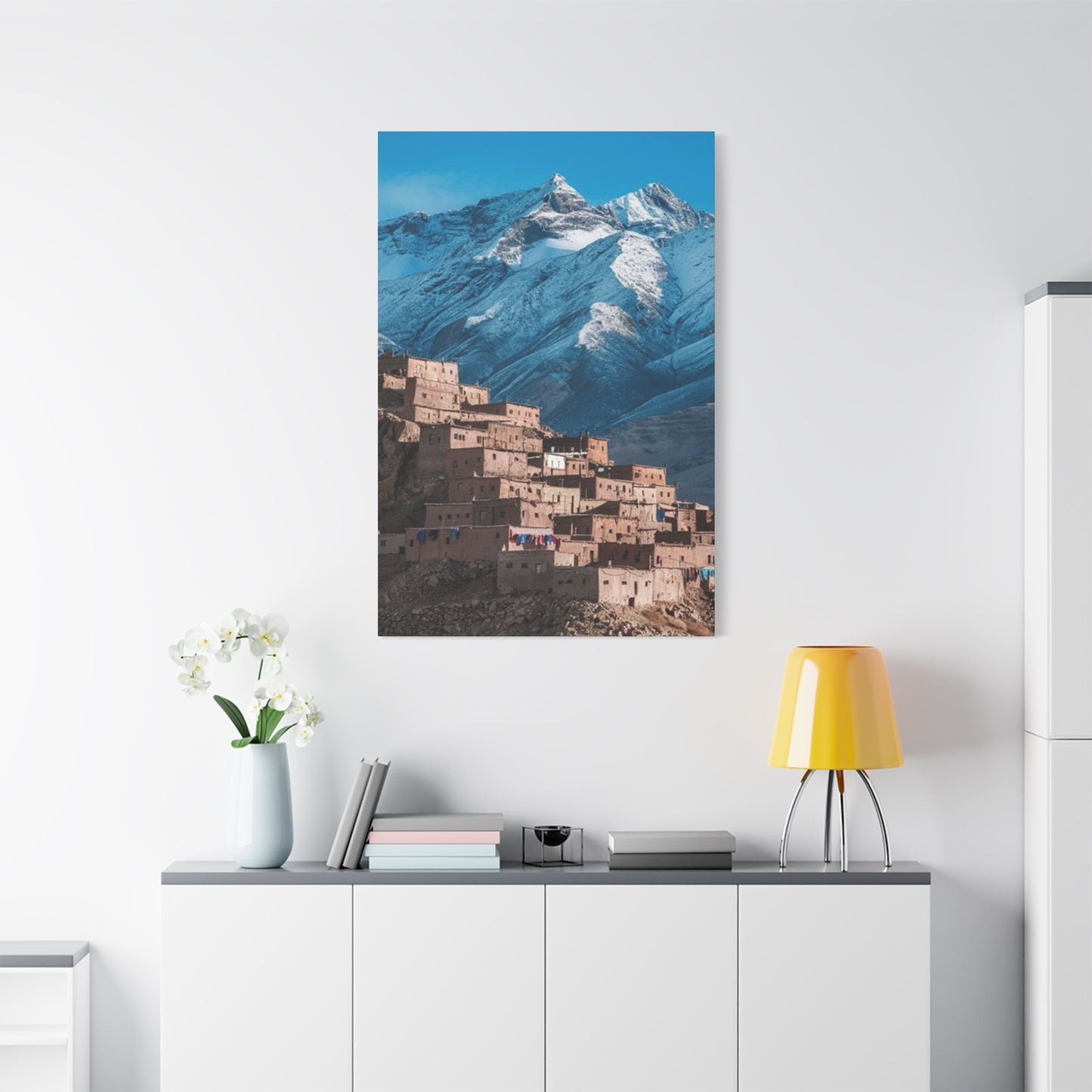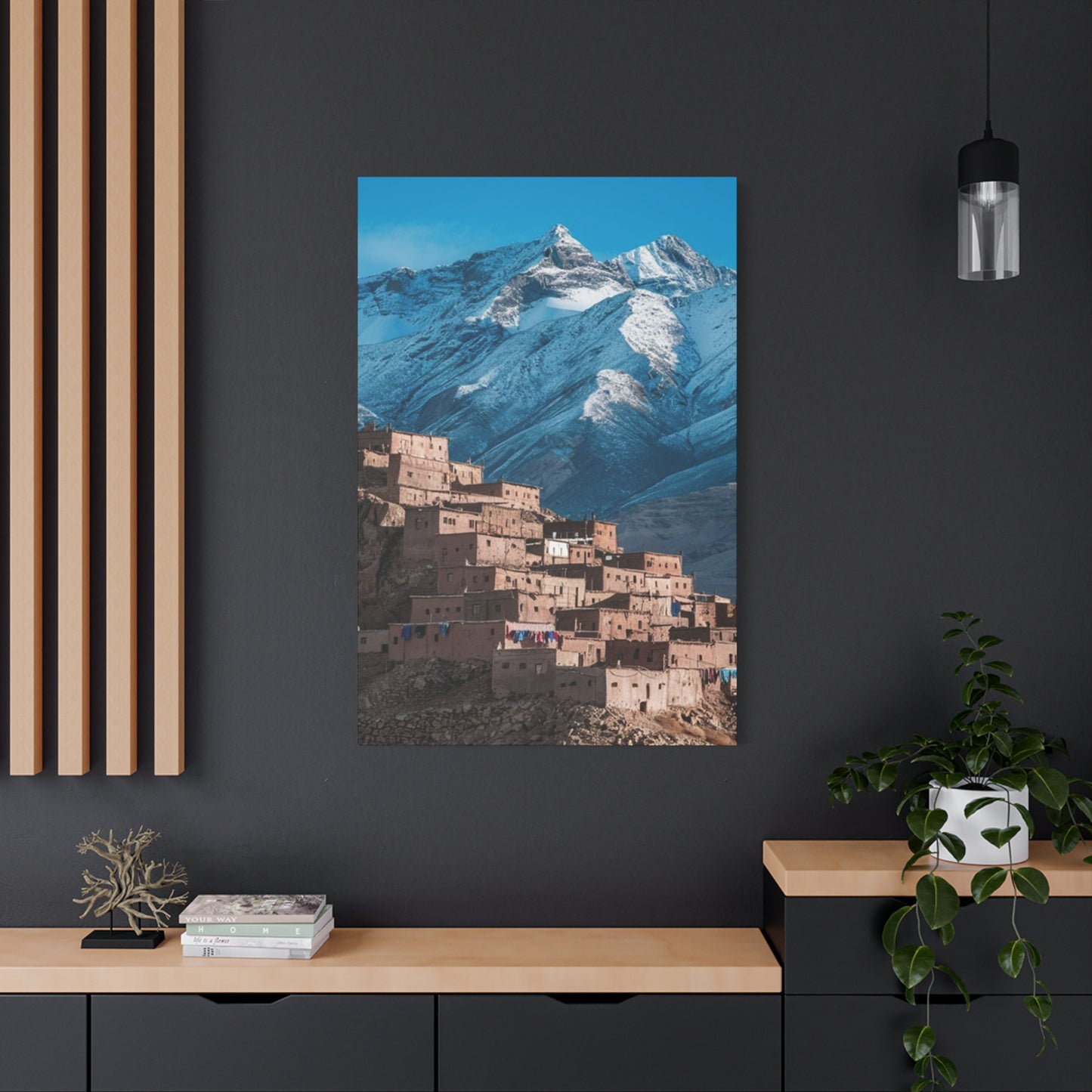Sacred Peaks and Peaceful Walls: Exploring Snowy Monastery Wall Art
The intersection of spiritual architecture and natural winter landscapes creates an extraordinary visual experience that resonates deeply with those seeking peace and contemplation. When snow-covered mountain peaks meet the timeless walls of monasteries, a unique aesthetic emerges that speaks to both the soul and the senses. This powerful combination has inspired artists, designers, and homeowners to bring these elements into interior spaces, creating sanctuaries of calm within modern living environments.
The appeal of monastery structures set against snowy mountain backdrops extends far beyond simple aesthetics. These scenes carry centuries of contemplative tradition, representing spaces where seekers have retreated from the world to find inner peace. The pristine white of fresh snow symbolizes purity and new beginnings, while the solid walls of sacred buildings represent stability and spiritual grounding. Together, they form a visual language that communicates tranquility without words.
Contemporary interior design increasingly draws inspiration from these spiritual winter landscapes. Homeowners and decorators recognize the transformative power of imagery that combines natural majesty with human-crafted sanctuaries. The result is a growing movement toward incorporating these themes into living spaces, offices, and meditation rooms. This trend reflects a broader cultural shift toward mindfulness and the creation of personal retreats within our daily environments.
The following exploration delves into twenty distinct aspects of this artistic phenomenon. Each section examines how snowy monastery imagery influences modern decor, spiritual practice, and aesthetic appreciation. From the psychological impact of winter serenity to practical implementation strategies, this comprehensive look reveals why these visual themes continue to captivate and inspire.
Tranquility in Snow: Monastery Wall Art Inspirations
The concept of tranquility finds perfect expression when winter landscapes merge with spiritual architecture. Monasteries nestled in snowy regions have long served as symbols of peace, their remote locations offering both physical isolation and metaphorical separation from worldly concerns. When translated into wall art, these scenes bring an immediate sense of calm to any space they inhabit.
The visual impact of a monastery standing resolute against a backdrop of snow-laden mountains creates multiple layers of meaning. The warmth suggested by the building's shelter contrasts beautifully with the cool expanses of winter surrounding it. This juxtaposition speaks to the human need for sanctuary while acknowledging the wild, untamed beauty of nature. The composition naturally draws the eye inward, encouraging contemplation and reflection.
Artists who specialize in this genre understand the delicate balance required to capture authentic tranquility. The color palette typically remains subdued, with whites, grays, and soft earth tones dominating the composition. Occasional touches of warmth might appear in the glow of windows or the natural wood of doors and beams, suggesting life and warmth within the sacred walls. These subtle details prevent the scene from feeling cold or unwelcoming while maintaining the overall sense of peaceful quietude.
The architectural elements of monasteries contribute significantly to the tranquil atmosphere these images project. Simple, clean lines reflect the minimalist philosophy often associated with spiritual practice. Unnecessary ornamentation falls away, leaving only essential forms that serve both practical and symbolic purposes. This simplicity resonates with modern design sensibilities while connecting to ancient traditions of contemplative living.
Snow acts as nature's minimalist in these compositions, covering complexity with pristine simplicity. It softens hard edges, muffles sound in the viewer's imagination, and creates a blank canvas that focuses attention on the monastery itself. The interplay between the built structure and the natural snowscape demonstrates harmony between human creation and the environment, a theme that resonates deeply in our current age of environmental awareness.
Light plays a crucial role in conveying tranquility through these artistic representations. Winter light possesses unique qualities, often appearing softer and more diffused than in other seasons. Artists capture this by rendering gentle shadows and subtle gradations of tone. The resulting effect mimics the quiet luminosity of a snow-covered landscape, where light seems to emanate from within the scene itself rather than from a single source.
The psychological impact of viewing monastery snow art cannot be overstated. Research in environmental psychology demonstrates that natural scenes reduce stress and promote mental restoration. When combined with architectural elements associated with spiritual practice, the effect intensifies. Viewers often report feelings of peace, clarity, and renewed perspective after spending time with these images. This makes them particularly valuable in spaces dedicated to relaxation, meditation, or focused work.
Placement considerations enhance the tranquil qualities of monastery wall art. Spaces designed for quiet activities benefit most from these visual themes. Bedrooms, reading nooks, meditation corners, and personal offices transform when graced with imagery that promotes calmness. The art serves as a visual anchor, a point of focus that helps settle the mind and create psychological distance from daily stressors.
The scale of the artwork influences its impact on tranquility. Larger pieces can create an immersive experience, almost serving as windows into another world. Viewers feel transported to the peaceful monastery setting, experiencing a momentary escape from their immediate surroundings. Smaller pieces work differently, offering concentrated points of calm that punctuate a space without overwhelming it. Both approaches have merit depending on the room's purpose and the desired effect.
Texture adds another dimension to tranquil monastery art. Whether through the medium itself, such as canvas with visible weave, or through printing techniques that create subtle relief, texture engages multiple senses. The eye perceives depth and dimensionality, while the mind imagines the feel of cold stone walls or soft snow. This multisensory engagement deepens the viewer's connection to the peaceful scene.
Seasonal considerations affect how monastery snow art functions in a space. In winter months, these images harmonize with the outdoor environment, creating continuity between inside and outside. During warmer seasons, they offer a cooling visual contrast, a reminder of nature's cyclical patterns and the full spectrum of earthly experience. This year-round relevance makes monastery snow art a versatile choice for permanent installation.
The cultural significance of monasteries adds layers of meaning to their artistic representations. These structures represent centuries of human spiritual seeking across diverse traditions. Buddhist monasteries clinging to Himalayan slopes, Christian abbeys in Alpine valleys, and contemplative centers in other mountain ranges all share common themes of dedication, simplicity, and the pursuit of higher understanding. Art featuring these spaces taps into this rich heritage, offering viewers a connection to traditions of wisdom and peace.
Contemporary artists bring fresh perspectives to traditional monastery snow imagery. Some employ photorealistic techniques that capture every detail with stunning precision. Others embrace more interpretive approaches, using abstraction or impressionism to convey the emotional essence rather than literal appearance. This diversity ensures that monastery snow art can suit various aesthetic preferences and interior design styles.
Digital technology has expanded the possibilities for creating and displaying monastery wall art. High-resolution photography allows capture of remote locations in exquisite detail. Digital painting tools enable artists to craft imagined scenes that feel completely authentic. Advanced printing methods reproduce these works with remarkable fidelity, bringing gallery-quality pieces within reach of broader audiences. These technological advances democratize access to tranquil monastery art.
The timelessness of monastery snow imagery ensures its continued relevance across changing design trends. While specific styles of furniture, color schemes, and decorative accessories may come and go, the fundamental human response to peaceful winter landscapes and spiritual architecture remains constant. Investing in quality monastery wall art means acquiring pieces that will continue to resonate for years to come.
Collecting monastery snow art can become a meaningful personal journey. Some enthusiasts focus on specific geographic regions, gathering representations of monasteries from particular mountain ranges. Others collect works by favored artists, appreciating individual interpretations of the theme. Still others curate collections that trace the evolution of the artistic genre itself. Each approach offers opportunities for learning, appreciation, and the gradual refinement of personal taste.
The Magic of Snowy Peaks in Sacred Art
Snow-covered mountain peaks have captivated human imagination since ancient times, featuring prominently in spiritual and artistic traditions worldwide. When these majestic natural formations appear in sacred art, particularly alongside monastery structures, they take on additional layers of symbolism and meaning. The magic lies not just in their visual grandeur but in what they represent to the human spirit.
Mountains themselves carry profound symbolic weight across cultures. They represent challenges to overcome, heights to aspire toward, and proximity to the divine realm. Many religious traditions situate their holiest sites on mountaintops or in mountain ranges, recognizing these elevated spaces as thresholds between earthly and spiritual dimensions. Snow-covered peaks amplify this symbolism through their pristine appearance and the harsh conditions required to reach them.
The technical challenges of depicting snowy peaks in art have inspired innovation across centuries. Early religious artists developed techniques for rendering snow's unique reflective properties using limited materials. They learned to suggest the crystalline nature of snow, its ability to capture and scatter light, and the way it transforms familiar landscapes into otherworldly vistas. These traditional methods continue to inform contemporary sacred art.
Color theory plays a fascinating role in representing snowy peaks effectively. While snow appears white, artists know it contains infinite subtle variations of blue, purple, pink, and gray depending on light conditions and time of day. Sacred art often emphasizes cooler tones to convey spiritual purity while introducing warmer accent colors to prevent coldness from overwhelming the composition. This careful color balancing creates visual harmony that supports the meditative qualities of the work.
The scale relationship between monastery structures and mountain peaks contributes to the magical quality of these compositions. Artists typically render mountains as vast, dominating presences that dwarf human-built structures. This scale relationship acknowledges nature's power while simultaneously celebrating humanity's courage in establishing spiritual outposts in such challenging environments. The contrast emphasizes both humility and determination.
Atmospheric perspective becomes particularly important when depicting snowy peaks in sacred art. Distant mountains fade into lighter values and cooler colors, suggesting vast spaces and emphasizing the journey required to reach them. This technique creates depth while also serving metaphorical purposes, representing the long path of spiritual development. Viewers intuitively understand that reaching those distant peaks requires dedication and perseverance.
The seasonal specificity of snow adds temporal dimension to sacred mountain art. Unlike perpetually visible landscape features, snow comes and goes, marking time's passage and nature's cycles. Art featuring snowy peaks captures a particular moment, a specific season, reminding viewers of impermanence and change. This temporal quality aligns with spiritual teachings about accepting life's transient nature.
Light effects on snowy peaks provide artists with spectacular opportunities for dramatic impact. Alpenglow, the rosy light that sometimes illuminates mountains at dawn and dusk, creates breathtaking moments that seem to transcend ordinary reality. When captured in sacred art, these effects suggest divine presence, moments when the veil between worlds grows thin. Such images possess an undeniable magical quality that moves viewers deeply.
The isolation associated with snowy mountain peaks enhances their spiritual significance in art. These remote locations require effort to access, separating them from everyday life. Monasteries situated in such places make deliberate statements about retreat from worldly concerns. Art depicting these isolated sacred spaces invites viewers to mentally journey away from their immediate circumstances toward places of deeper contemplation.
Wind patterns visible in snowy mountain scenes add dynamism to otherwise static compositions. Snow plumes streaming from ridges and peaks suggest movement and energy even in frozen landscapes. Artists capture these elements to prevent their works from feeling lifeless or sterile. The suggested motion reminds viewers that even in places of profound stillness, natural forces continue their eternal dance.
Minimalist Monastery Walls with Mountain Views
The minimalist aesthetic finds perfect expression in monastery architecture, where functional simplicity serves both practical and spiritual purposes. When these unadorned walls frame spectacular mountain views, particularly snow-covered peaks, the resulting visual experience embodies minimalism's core principles. The deliberate reduction of unnecessary elements focuses attention on what truly matters, creating powerful contemplative spaces.
Monastery design traditionally emphasizes utility over ornamentation. Thick stone walls provide insulation and security. Small, strategically placed windows conserve heat while framing specific views. Simple doorways permit passage without decoration. This practical minimalism arose from necessity in remote, harsh environments but evolved into an aesthetic philosophy that celebrates restraint and intentionality.
The concept of borrowed scenery, developed extensively in Asian garden design, applies beautifully to monastery architecture in mountain settings. Rather than creating elaborate interior decorations, monastery builders allowed natural mountain vistas to serve as artwork. Windows become frames for ever-changing natural paintings, with shifting light, weather, and seasons providing infinite variation within simple architectural openings.
Modern minimalist design draws direct inspiration from monastery aesthetics. Clean lines, neutral color palettes, and emphasis on negative space all echo monastic interiors. Contemporary designers recognize that these spaces achieve remarkable beauty through subtraction rather than addition. A white monastery wall with a single window opening onto snowy peaks demonstrates that more can indeed be less.
The psychological impact of minimalist monastery spaces has been documented across contemplative traditions. Simplified environments reduce sensory overwhelm, allowing deeper focus and clearer thinking. When these spare interiors offer views of majestic mountains, they create ideal conditions for meditation and reflection. The external grandeur contrasts with internal simplicity, suggesting that inner stillness allows fuller appreciation of outer beauty.
Wall treatments in minimalist monastery design typically involve natural materials with minimal processing. Stone, plaster, or whitewash creates surfaces that show texture and age without deliberate decoration. These honest materials develop character over time, gaining beauty through natural weathering rather than applied ornament. In artwork depicting these spaces, artists capture this authentic material quality.
The relationship between wall thickness and window depth becomes an important design element in monastery architecture. Deep reveals created by thick walls frame mountain views dramatically, creating natural vignettes that direct attention. This architectural feature translates effectively into two-dimensional art, where careful rendering of depth and shadow recreates the framing effect and enhances the sense of looking through a portal.
Light quality transforms throughout the day in minimalist monastery spaces with mountain views. Morning light might flood through eastern windows, illuminating white walls and creating soft, diffused brightness. Evening light could cast long shadows and warm tones across stone surfaces. Artists depicting these spaces often choose specific times of day to capture particular light effects that enhance the minimalist aesthetic.
The absence of clutter in monastery environments allows full appreciation of what remains. A single window, a simple wooden bench, a candle holder mounted on stone – each element gains significance through isolation. When artists recreate these spare interiors with their mountain views, they practice visual economy, trusting that viewers will find richness in simplicity rather than demanding excessive detail.
Color palettes in minimalist monastery art naturally trend toward neutrals and earth tones. Whites and off-whites dominate wall surfaces, while stone introduces grays and tans. Wood elements provide warm browns. The snowy mountains visible through windows add brilliant whites and cool blue tones. This restrained palette creates visual harmony while allowing subtle variations to register powerfully.
Negative space functions as an active compositional element in minimalist monastery art. Empty walls, blank floors, and unadorned ceilings create visual breathing room that prevents claustrophobia despite the typically small scale of monastery cells and chambers. These empty areas also serve metaphorically, representing the cleared mind that contemplative practice seeks to develop.
The geometric simplicity of monastery architecture lends itself well to minimalist artistic representation. Rectangular walls, square windows, and linear elements create clean compositions that feel both modern and timeless. Artists can emphasize these geometric qualities, creating works that appeal to contemporary sensibilities while remaining faithful to traditional architectural forms.
Shadow and light patterns on minimalist monastery walls become subjects worthy of artistic attention in themselves. A shaft of sunlight crossing a white plastered wall, shadows cast by a window frame, or the subtle gradation of light across a curved vault – these ephemeral phenomena demonstrate that minimalist spaces contain abundant visual interest for those patient enough to observe carefully.
Winter Serenity: Wall Art for Peaceful Spaces
Creating peaceful spaces within our homes and workplaces has become increasingly important in modern life. Wall art featuring winter monastery scenes serves as a powerful tool for establishing serenity in interior environments. The combination of snowy landscapes, spiritual architecture, and contemplative atmosphere inherent in these images makes them particularly effective for spaces dedicated to relaxation and mental restoration.
The psychology of peaceful spaces reveals why certain visual elements consistently promote calmness. Research demonstrates that nature imagery reduces physiological stress markers, lowering blood pressure and heart rate. Cool color palettes associated with winter scenes have calming effects, unlike warmer colors that tend to energize. Horizontal compositions suggest stability and rest rather than dynamic movement. Winter monastery art naturally incorporates all these elements.
Bedroom environments benefit especially from winter serenity wall art. The space where we sleep requires psychological separation from daytime concerns and activities. Artwork featuring peaceful monastery snow scenes creates appropriate visual atmosphere, signaling to the mind that this space serves as sanctuary. Placed where it becomes the last image seen before sleep and first viewed upon waking, such art frames the day with tranquility.
Home offices and workspaces present different challenges that winter monastery art can address effectively. Concentration requires mental clarity that cluttered, overstimulating environments undermine. A serene winter scene provides a visual anchor point where eyes can rest during breaks from screen work or detailed tasks. This brief visual respite allows mental reset, improving focus when attention returns to work.
Meditation rooms and yoga studios find natural partners in winter monastery wall art. These dedicated practice spaces benefit from consistent visual themes that support their purpose. Imagery associated with established contemplative traditions lends authority and depth to personal practice spaces. The winter element adds freshness and purity to the atmosphere, qualities that enhance meditative states.
Living rooms and common areas sometimes lack peaceful qualities due to their multiple uses and traffic patterns. Strategic placement of winter serenity art can create calm zones within these busier spaces. A large piece above a sofa or flanking a fireplace establishes a visual anchor that influences the entire room's atmosphere, bringing order and tranquility to potentially chaotic environments.
Healthcare settings increasingly incorporate peaceful art as part of therapeutic environments. Waiting rooms, patient recovery areas, and counseling offices all benefit from winter monastery imagery. The non-denominational spiritual quality appeals across diverse populations while providing the stress-reduction benefits that support healing and wellbeing. The familiar comfort of snow scenes transcends cultural boundaries.
The size and scale of winter serenity art influence how effectively it creates peaceful atmospheres. Oversized pieces can transform entire walls into windows onto tranquil scenes, creating immersive experiences that transport viewers mentally. Medium-sized works provide substantial presence without overwhelming smaller rooms. Even modest pieces contribute to peaceful environments when thoughtfully placed and properly lit.
Lighting considerations dramatically affect how winter monastery art functions in space. Natural daylight reveals the subtle color variations and details that make these pieces come alive. Artificial lighting requires more careful planning – warm bulbs might clash with cool winter palettes while cooler LED lighting can enhance the crisp, fresh feeling of snow scenes. Dedicated picture lights ensure the artwork receives appropriate illumination regardless of ambient conditions.
Snowy Mountain Monasteries in Modern Decor
The integration of traditional monastery imagery into contemporary interior design creates fascinating aesthetic tensions and harmonies. Snowy mountain monasteries, representing centuries-old spiritual architecture and timeless natural landscapes, find surprisingly comfortable homes in modern decor schemes. This successful fusion demonstrates how authentic, meaningful imagery transcends stylistic boundaries when thoughtfully incorporated.
Modern interior design often emphasizes clean lines, minimal ornamentation, and functional beauty – principles that align remarkably well with monastery architecture. The simple geometric forms of traditional spiritual buildings complement rather than contradict contemporary aesthetics. When rendered against snowy mountains, these structures gain additional modern appeal through their environmental integration and sustainable building principles that resonate with current values.
The neutral color palettes dominating modern decor provide ideal backdrops for snowy monastery art. Contemporary spaces often feature whites, grays, and earth tones as foundational colors, occasionally punctuated by bold accent colors. Monastery snow scenes work beautifully within these schemes, their own neutral palettes harmonizing with surroundings while their natural content adds warmth and interest that pure abstract design sometimes lacks.
Industrial-style interiors, characterized by exposed brick, metal fixtures, and raw materials, might seem unlikely partners for monastery art. However, the honest materiality of industrial design shares philosophical common ground with monastery architecture's functional simplicity. Snowy mountain monastery pieces add softness and spiritual dimension to industrial spaces without compromising their edgy, urban character.
Scandinavian design, with its emphasis on natural light, simplified forms, and connection to nature, provides particularly hospitable environments for monastery snow art. The Nordic aesthetic philosophy, deeply influenced by harsh winters and appreciation for light, finds natural kinship with imagery of snow-covered monasteries. These pieces enhance rather than disrupt the hygge-focused calmness that Scandinavian interiors cultivate.
Mid-century modern spaces, experiencing renewed popularity, successfully incorporate monastery mountain imagery through careful attention to presentation. The organic forms and natural materials favored in mid-century design complement the natural content of monastery art. Pairing a classic Eames chair with wall art featuring a snow-covered Alpine monastery creates an eclectic yet cohesive aesthetic that honors both traditional and modern design excellence.
Minimalist decor schemes, perhaps more than any other contemporary style, naturally embrace monastery snow art. Both minimalism and monastic design share philosophical commitments to essentialism and the elimination of excess. A single large photograph of a Himalayan monastery against snowy peaks becomes the perfect focal point in a minimalist room, providing visual interest while respecting the overall philosophy of restraint.
Transitional interiors, blending traditional and contemporary elements, find balance through monastery mountain artwork. These pieces carry historical and spiritual weight that satisfies the traditional aesthetic while their photographic or modern painterly execution appeals to contemporary tastes. The natural subject matter serves as common ground between old and new design sensibilities.
The material quality of how monastery art is produced and presented influences its success in modern decor. Traditional canvas prints work well in many settings, but contemporary spaces might benefit from alternative presentations like metal prints, acrylic face mounts, or frameless edge-wrapped canvases. These modern production methods respect the timeless content while updating the presentation for current sensibilities.
Open-concept living spaces, a hallmark of modern residential design, require careful art selection to maintain flow while defining distinct zones. Large-scale monastery snow scenes can subtly delineate space – for instance, distinguishing a living area from a dining space – without requiring physical barriers. The art creates psychological boundaries through visual anchoring while preserving the open, airy feeling.
Modern workspace design, whether in commercial offices or home environments, increasingly prioritizes employee wellbeing and psychological comfort. Monastery mountain imagery contributes to these goals by providing contemplative focal points that reduce stress. In collaboration spaces, such art can symbolically encourage the quiet focus and dedicated effort that monasteries represent, supporting productive work culture.
The technology sector, known for modern design sensibilities, has embraced monastery mountain imagery in corporate environments. Tech companies understand that creativity and innovation require both intense focus and mental restoration. Art featuring peaceful winter monasteries in shared spaces and individual offices supports this balance, providing visual respite from screen-dominated workdays while inspiring the kind of dedicated pursuit of excellence that monastic traditions embody.
Boutique hotels and hospitality venues leverage monastery snow art to create memorable, peaceful guest experiences. Modern hotel design seeks to provide sanctuary from travel stress while reflecting local character or conveying specific moods. Monastery mountain imagery achieves multiple goals simultaneously – establishing a calm atmosphere, suggesting luxury through association with rare and beautiful locations, and providing talking points that enhance guest experience.
Heaven in White: Art of the High Peaks
High in the mountains, where silence reigns and snow blankets the earth like a sacred veil, stand monasteries whose walls hold centuries of stories. These remote spiritual sanctuaries are not just places of worship—they are living galleries, where faith is expressed in colors, symbols, and brushstrokes that echo through generations. The art found in these high-altitude monasteries reflects both the physical beauty of their surroundings and the profound spirituality that guides those who live there. The landscape is not merely a backdrop; it is part of the spiritual language, shaping the way sacred art is created, perceived, and preserved.
The snow outside often finds its way into the paintings within. Soft white backgrounds, delicate brushwork, and symbols of purity reflect the harmony between the natural and the divine. In the stillness of winter, the whiteness of the mountains suggests a blank canvas, a space untouched by the noise of the world below. This visual language of purity is mirrored in the murals and thangkas—sacred scroll paintings—that adorn the monastery walls. Monastic artists use pigments carefully ground from minerals, plants, and sometimes even gold leaf, ensuring the images endure as long as the mountains themselves.
Artists who create these works are often monks themselves, working in quiet devotion rather than seeking personal recognition. Every line and shade carries centuries of tradition, taught through meticulous apprenticeship. The creation of a single mural can take months, even years, as it is accompanied by ritual, chanting, and meditation. The act of painting is considered a spiritual practice in itself—an offering rather than a profession. Their creations are less about individual expression and more about sustaining a shared spiritual legacy, linking past, present, and future generations of practitioners.
The themes often include heavenly realms, divine beings, and sacred peaks that mirror the mountains just outside the monastery walls. Gods and bodhisattvas are depicted with serene faces and luminous halos, set against snowy landscapes that evoke both the physical world and higher planes of existence. Gold leaf may glimmer like sunlight on snow, while soft blues and whites suggest a serene, otherworldly calm. The snow-covered peaks are not simply a scenic element but a metaphor for enlightenment itself—pure, elevated, and eternal.
To visitors, these paintings feel like windows into another dimension—a meeting point between earth and heaven. To the monks, they are reminders of inner stillness, discipline, and connection to something greater than themselves. As the wind whistles outside and prayer flags flutter against the pale sky, the sacred art inside seems to hum with quiet energy. Each image is an invitation to look inward, to rise above worldly concerns, and to glimpse the clarity of a mind like freshly fallen snow.
Walls that Whisper Prayers
Every brushstroke on a monastery wall carries more than pigment—it carries a prayer. In these sacred spaces, art and devotion merge seamlessly, transforming plain stone walls into silent storytellers of faith, hope, and transcendence. These murals and frescoes are far more than mere decoration; they are living, breathing visual scriptures that whisper ancient prayers to those who pause long enough to listen and truly see.
The process of creating these images is itself an act of worship. The walls are often painted in quiet solitude by devoted monks, who approach their work with deep reverence and intention. Each image is carefully composed, not only for its aesthetic value but also for the spiritual messages it conveys. A lotus flower might symbolize purity and spiritual awakening, while a towering mountain represents stability, endurance, and the lofty heights of enlightenment. Circles—often depicted as mandalas—embody eternity and the cyclical nature of existence. These sacred symbols speak in a universal language, transcending cultural and linguistic barriers, allowing even those unfamiliar with the monastery’s traditions to feel a profound sense of peace and connection.
Unlike bold, flashy works of art that demand immediate attention, these murals have a subtle, almost meditative presence. They do not shout; instead, they gently invite visitors into stillness and reflection. Those who enter the monastery halls often describe an uncanny calm, as if the walls themselves are breathing softly alongside them. This sensation is heightened by the slow accumulation of time—layers of smoke from butter lamps mingle with the cool mountain air, imparting a soft patina to the paintings. This natural aging gives the artwork a textured, almost living quality, as if the prayers embedded in the pigments continue to pulse quietly beneath the surface.
The walls’ whispering nature extends beyond their visual impact. They serve as keepers of prayers offered centuries ago—prayers for peace amidst turmoil, for compassion in a harsh world, and for enlightenment beyond suffering. In their enduring silence, these images speak more deeply than words ever could. They carry the hopes, fears, and faith of countless generations, silently inviting all who enter to join in this ongoing dialogue of devotion.
The monastery’s walls, layered with these sacred paintings, become a bridge between the human and the divine. Each image is an invitation to contemplate the mysteries of existence and the path toward inner transformation. Visitors find themselves drawn into a space where time seems to slow, and the noise of everyday life fades away. The walls whisper, and in their whispers, a sacred stillness is born.
Ultimately, the beauty of these whispering walls lies not only in their exquisite visuals but also in their quiet endurance. They stand as timeless guardians of spiritual wisdom and heartfelt prayer. Their silent voices echo through the corridors of time, reminding us that even in silence, faith can speak volumes.
Frozen Temples, Living Art
Snow-covered monasteries perched high in the mountains may appear still and frozen from the outside, shrouded in silence and ice, but inside their ancient walls, life pulses vibrantly through art and ritual. The murals, thangkas, and intricate carvings that adorn these sacred spaces are far from being mere relics of a bygone era; they are living art forms, continuously renewed and imbued with vitality through prayer, ritual practice, and devoted care.
Many of these monasteries are nestled in remote, icy regions where the environment is as harsh as it is breathtaking. The cold air, crisp and unyielding, preserves the vivid colors of ancient paintings in ways warmer climates cannot. The vibrant reds, deep blues, and shimmering golds seem to defy time itself, standing strong against the biting winds and heavy snows that sweep across these high-altitude sanctuaries. Yet it is not only nature that sustains these artworks. Generations of monks, trained in both spiritual practice and artistic preservation, have meticulously cared for and restored these images. Their dedication creates a rare harmony—a delicate balance where preservation meets devotion, and the sacredness of the art remains intact.
These artworks transcend simple representation; they serve as profound spiritual guides. The murals often depict celestial beings, protective deities, and expansive cosmic landscapes—visual embodiments of both the outer physical world and the inner realms of consciousness. Each image invites the practitioner, or even a contemplative visitor, to look beyond the surface and meditate on the eternal cycles of existence: birth, death, and rebirth, the interplay of light and darkness, and the quest for enlightenment. They offer a roadmap for the soul’s journey, painted with symbolic depth and spiritual intention.
Even in the stillness of winter, when the landscape outside is hushed beneath a thick blanket of snow, the art within these frozen temples is unmistakably alive. Flickering butter lamps cast a warm, golden glow on the painted faces, making them appear to move, breathe, and watch silently over the worshippers. The soft illumination breathes life into every brushstroke, creating an atmosphere charged with quiet energy and sacred presence. Accompanying these visual wonders are ritual chants that fill the halls, weaving sound and spirit into the painted narratives. The combination of light, sound, and image evokes a multisensory experience where the sacred art transcends its physical form to become a living, breathing presence.
The phrase “Frozen Temples, Living Art” beautifully encapsulates this compelling contrast: a world where snow and ice freeze the landscape into a silent stillness, but faith, devotion, and spiritual practice keep the spirit—and the art—eternally alive and vibrant. These mountain monasteries become sanctuaries not only of faith but of artistic expression that continues to inspire and guide all who enter their doors. Through the harshness of winter and the passage of time, the living art within these temples reminds us that beauty and belief can endure even in the coldest, most remote places on earth.
Spiritual Landscapes in Snow
Snow has a remarkable power to transform landscapes, turning even the most rugged mountains into serene, almost otherworldly realms. In these high-altitude regions, monasteries rise gracefully against the backdrop of pristine white peaks, their ancient walls adorned with paintings that mirror the surrounding scenery. These spiritual landscapes—both outside in nature and inside within the sacred halls—create a profound sense of harmony between the natural world and faith. They invite all who witness them into a timeless dialogue between earth and spirit.
The murals inside these monasteries often depict expansive mountain ranges, flowing rivers, and vast skies painted in gentle, soothing tones. These natural elements are not just decorative motifs; they carry deep symbolic meaning. Mountains symbolize strength and the journey toward enlightenment, rivers suggest the flow of life and purification, and the skies evoke infinite space and the divine. Snow, in particular, emerges as a powerful spiritual metaphor within this artistic vocabulary. Its pure white blanket represents clarity, purity, and stillness—a visual embodiment of the inner peace that spiritual practice seeks to cultivate. In this way, nature is not a separate entity from the sacred but is itself a manifestation of the divine.
The artists behind these works, often monks deeply rooted in their spiritual and natural surroundings, draw directly from the daily vistas they behold. A distant peak transforms into a symbol of enlightenment—a lofty goal of spiritual attainment. A gentle snowfall becomes an image of quiet, contemplative peace. The careful use of whites, blues, and golds captures the calm majesty of winter landscapes while imbuing the paintings with layers of spiritual significance. Gold leaf may glimmer like the morning sun reflecting off snow, while blues and whites create a cool, meditative atmosphere that invites introspection.
For visitors who stand before these paintings, the experience is often transformative. It is as if they are standing at the threshold of something timeless and vast. The snow outside muffles every sound, lending a hushed silence to the environment, while the art inside reverberates with an echo of quiet contemplation. Together, the silent landscape and the sacred imagery create a meditative atmosphere that encourages self-reflection, stillness, and a deepened awareness of the present moment.
In these snowy monasteries, spiritual landscapes are not merely depicted on walls or canvases—they are lived and experienced daily by those who dwell there. The boundary between canvas and mountain, between human and divine, becomes blurred and porous, melting away like snow under the gentle warmth of the morning sun. The sacred art does not just represent the spiritual path; it becomes part of it, a living extension of the surrounding natural world. Here, faith is inseparable from the landscape itself, creating a holistic vision of heaven on earth.
Conclusion
Snowy monastery wall art stands as one of the most profound visual expressions of spiritual devotion, cultural identity, and human reverence for nature’s majesty. At its core, this art is not merely decorative but deeply symbolic—a visual bridge connecting earthly existence to the transcendent realms of the sacred. These paintings and carvings, often depicting snow-covered peaks, serene landscapes, and divine figures, capture both the spiritual aspirations of communities and the unique environmental conditions in which these monasteries stand. When one examines these walls, it is not just pigment and stone that are observed, but centuries of prayer, meditation, and cultural continuity.
The serene imagery of snowy peaks within these monastery walls symbolizes more than a geographic reality. Mountains, often covered in perpetual snow, are revered in many spiritual traditions as places of divine presence, solitude, and enlightenment. For monks and pilgrims, these peaks represent a spiritual summit—a metaphorical path to higher understanding and ultimate truth. Wall art, in this context, becomes a means to bring the sacred landscape indoors, allowing those who enter the monastery to feel enveloped by the calm strength of nature even while in a protected sacred space.
Another powerful dimension of snowy monastery wall art is its role in storytelling. Each brushstroke, color choice, and pattern often carries deep meaning, representing ancient legends, divine beings, and spiritual teachings. These narratives serve both as moral guidance for the monastic community and as a visual scripture for those unable to read or write. The frozen peaks painted on the walls act as silent witnesses, reminding visitors of the timelessness of spiritual quests and the endurance required to ascend metaphorical—and sometimes literal—mountains.
The peacefulness conveyed by these wall paintings is intentional and profound. In a world often marked by noise and chaos, monasteries have long served as sanctuaries of stillness. The art on their walls reflects and reinforces this quietude. Gentle color palettes, flowing lines, and balanced compositions invite the observer into a state of contemplation. Snow itself, often depicted in soft whites and blues, symbolizes purity, silence, and clarity. In many spiritual philosophies, silence is not emptiness but fullness—the space in which the divine can be heard. The snowy imagery amplifies this quiet power, creating an atmosphere of serenity and introspection.
It is also important to recognize that snowy monastery wall art reflects a harmonious relationship between humans and their natural environment. These monasteries are often built in remote, mountainous regions where snow is not just an aesthetic element but a living reality. By incorporating the surrounding landscape into their artistic expressions, monks demonstrate a deep respect for the environment. This intertwining of art, nature, and spirituality encourages a worldview that sees the natural world not as something to dominate, but as something to honor and protect.
Furthermore, the preservation of this art speaks to the resilience of cultural heritage. For centuries, despite harsh climates, political upheavals, and modernization, these monastery walls have retained their beauty and significance. The artists who created these works often remained anonymous, devoting their craft as an act of spiritual service rather than personal fame. Their legacy endures, allowing future generations to witness the same serene peaks and sacred stories that inspired monks centuries ago. Each preserved mural is not only a work of art but also a historical document—a silent guardian of spiritual continuity.
The experience of standing before snowy monastery wall art is transformative for many. It transcends cultural and religious boundaries, offering a universal message of peace, stillness, and reverence for nature. Whether viewed by a devout pilgrim, an art historian, or a casual traveler, the quiet power of these walls invites reflection on the human search for meaning in an ever-changing world. In their silence, they speak volumes about faith, endurance, and the deep human desire for connection with something greater than oneself.
In the modern era, where speed and distraction often dominate daily life, these sacred spaces and their art offer a necessary counterbalance. They remind us of the value of slowing down, listening to silence, and observing beauty with mindful presence. They challenge us to respect both spiritual traditions and the natural landscapes that inspire them.
Ultimately, snowy monastery wall art is more than an aesthetic experience—it is a living expression of humanity’s highest aspirations. It embodies harmony between the sacred and the natural, the human and the divine. Through these serene peaks and peaceful walls, we are reminded that art has the power to transcend time, unite cultures, and speak a language older and deeper than words. These walls, painted with devotion and shaped by centuries of faith, continue to offer refuge, inspiration, and a timeless invitation to pause and reflect.

















